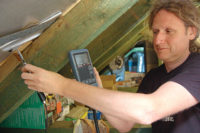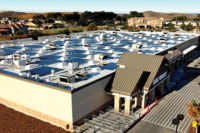As technology advances at a dizzying pace, and as more companies multiply their data storage needs, air handlers are evolving to keep up with the cooling and climate-control needs of computer rooms and data centers. But, how are manufacturers meeting those needs, and what will the future hold?
A Changing Market
Over the past few decades, the market for computer room and data center air handlers has exploded, said J.P. Valiulis, vice president of North America marketing, thermal management, Emerson Network Power.
“In 20 years’ time, we’ve seen a huge change,” he said. “Back then, it was a small computer dark room, and unless you were heavily computing, you didn’t use it much. Now, it’s mainstream. Even in a doctor’s office or shoe store, data has become strategic.”
“Computer rooms and data centers have evolved in many ways, spanning a wide spectrum of applications over the years,” said Lisa H. Ambrose, spokesperson for Skil-aire, a division of Tithe Corp. “We have a significant consolidation into co-location sites at one end of the spectrum, and we have, at the other end of the spectrum, small users providing temperature and humidity control to their servers and telecom equipment rooms within their own office compounds. Across the entire spectrum, we have growth in overall capacity to keep pace with the explosive nature of the Internet and computing in general — specifically addressing the rapid move to cloud computing.”
Valiulis agreed the exponentially growing need for data storage has resulted in a wide variety of cooling solutions. “Storage of what’s very important to us is now in all different shapes and sizes, from small broom closets to huge data centers with walls of servers. Because of those changes, cooling has changed a lot.”
Mike Smith, senior product marketing manager at Mitsubishi Electric US Cooling & Heating Division, stressed the importance of properly cooling computer rooms and data centers. “A cooling failure in a computer room could have a disastrous impact,” he said.
Ronnie Moffitt, principal applications engineer at Trane, a brand of Ingersoll Rand, also stressed the importance of redundancy in data center cooling. “Trane uses a fan array design that incorporates multiple direct-drive plenum fans,” he said. “If one of the fans fails, the others will make up for the loss. This does not take the place of the redundancy of additional units on a data center, but it adds another level of redundancy to these critical applications.”
Eric Taylor, marketing manager at AAON, said more low-ambient cooling options are now available to meet the year-round cooling requirements of data centers. “AAON H3 Series horizontal air-handling units are designed with an extremely low profile for use with under floor air distribution systems or overhead installations,” he said. “AAON rooftop units are also configurable as data center air-handling units with specific options such as economizers, return air bypass, and flooded condenser low-ambient controls.”
Focus on Efficiency
In addition to functionality, manufacturers have concentrated on improving the efficiency of air handlers used in data centers, which often requires a significant amount of cooling.
“All HVAC equipment has grown more efficient over time, which helps owners reduce energy use while still fulfilling the need for well-designed data centers,” Smith said. “More options for achieving redundancy are available now, giving engineers more choices than the traditional two or three types of data center designs.”
Valiulis said cooling equipment is becoming more efficient all the time, adding there is “often a tradeoff between the cost, efficiency, and longevity.”
Moffitt said fans have become much more efficient in recent years.
“Typically, direct-drive plenum fans have a blow-through design and can provide 65 percent or higher efficiency, which is a large improvement compared to the 55 percent range in older-model, belt-driven, forward-curved house fans,” he said.
“Along with conventional rooftop units and air-handling units, data center HVAC systems have increased in both full-load (EER) and part-load (SEER/IEER) efficiencies,” Taylor added. “Airside economizers are becoming required for data center applications because of the potential for energy savings, especially with the code and standard changes that allow a wider range of data center temperature and humidity conditions.”
Valiulis stated economization is a big trend that is becoming a regulatory requirement in some places. “In Seattle, you’re not allowed to install units above a certain tonnage without an economizer,” he said, adding that Emerson Network Power has developed a “pumped refrigerant economizer, the EconoPhase, which is a lot more efficient, and there are no worries of outside air being brought in.”
Moffitt said that economizers and evaporative cooling systems are cost-effective to operate as well as other advancements in technology. “Trane provides air-handling systems that use just these methods to cool; however, the central station air handlers can also utilize Trane chillers that are optimized to deliver water cooled to 60°-70°F with a 35 percent improved efficiency for data centers,” he said.
“Variable-refrigerant flow (VRF) zoning systems continue to lead the way in HVAC efficiency,” Smith added. “VRF zoning systems are designed to help buildings earn LEED [Leadership in Energy & Environmental Design] points from the U.S. Green Building Council [USGBC].”
The Future of Data Storage
As the market for computer room and data center cooling is only poised to grow in the future, so is the market for effective, affordable, and reliable cooling solutions. Manufacturers are already working on meeting those demands.
“Less critical data centers and computer rooms were previously served with air handlers meant for human comfort,” Smith said. “Those systems have now evolved to flexibly serve different types of spaces. HVAC systems can now be designed to meet the needs of a specific server rack layout, even if the layout is nontraditional. For example, units with directional vanes can be adjustable in spaces serving occupants but may be fixed in spaces like data rooms. This means the contractor doesn’t have to source equipment from multiple manufacturers, and also makes for simpler controls integration.
Data centers and server rooms are also going to become increasingly connected and remotely accessible, Valiulis predicted. “Imagine you’re at the University of Michigan campus, and you have something like 400 little computer closets,” he said. “The idea of having monitoring and data to give insight into those smaller spaces, being able to see and predict problems for proactive maintenance, and remotely diagnosing what’s going on — that whole idea of monitoring and alarming and having insight into those different rooms, that’s going to take steps in terms of sophistication and ease of installation.”
Valiulis added that data center cooling presents a great opportunity for HVACR contractors. “There are folks that specialize in this,” he said.” It’s a growing area, and it’s a unique opportunity for contractors. I would advise them to work with us to take advantage of the opportunity to learn about the equipment. There’s an enormous amount of opportunity there.”
In the end, each data center or computer room has its own unique requirements, depending on a number of factors, and it’s up to the contractor to find the best solution for each individual situation.
“Data centers are not a one-size-fits-all application — every customer has unique and specific needs,” Moffitt said. “We work with customers to design a system that can handle the temperature swings of the climate, yet minimize the changes seen by the electronic equipment. … The best solution is engineered by evaluating the energy-efficient options that are available, the climate where the building is located, and the electronic equipment being protected.”
Publication date: 6/16/2014
Want more HVAC industry news and information? Join The NEWS on Facebook, Twitter, and LinkedIn today!










